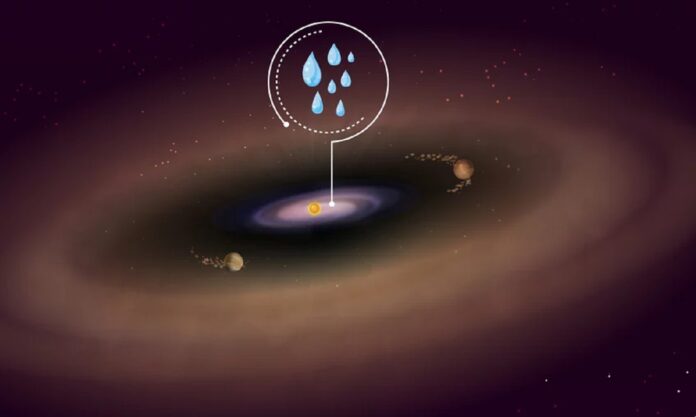Terrestrial and sub-Neptune planets are expected to form in the inner regions of protoplanetary disks. Water plays a key role in their formation, although it is unclear whether water molecules are formed in situ or transported from the outer disk.
A new study found evidence that water could also serve as one of the initial ingredients of rocky planets and be available at birth.
The MPIA-led MINDS research collaboration- using- JWST- has recently discovered water in the inner region of a disk of gas and dust around the young star PDS 70. Astronomers anticipate the region to be the birthplace of terrestrial planets. In a disk that contains at least two planets, this is the first finding of its kind.
Any rocky planets formed in the inner disk would benefit from a sizable local water reservoir, increasing the likelihood that they will become habitable. In addition to the subsequent collisions of water-bearing asteroids, this discovery provides evidence of a method to give water to possibly habitable planets even during their formation.
PDS 70 is the first relatively old disk (5.4 million years old) where astronomers discovered water. Planet-forming disks lose their gas and dust content over time. Dust and gas are either removed by the central star’s radiation or wind, or the dust expands into larger objects that eventually give rise to planets.
Astronomers hypothesized that water might not survive the severe star radiation, leading to barren, rocky planet-forming environments because previous investigations had not found water in the central portions of similarly developed disks.
The host star PDS 70 is located close to the disk’s center, where observations with the James Webb Space Telescope’s (JWST) MIRI (Mid-InfraRed Instrument) revealed the presence of water. This is the zone of the solar system where rocky planets orbit the Sun. The study indicates that the water is hot vapor with a temperature of about 330 degrees Celsius (600 Kelvin), which is scorching.
MPIA Director Thomas Henning says, “This discovery is fascinating, as it probes the region where rocky planets like Earth typically form.”
“MINDS is a JWST guaranteed-time program involving research institutes from 11 European countries. This survey aims to identify the properties of disks made of gas and dust around young stars, which can teach us about the conditions that determine the composition of planets potentially forming there.”
The crucial observation of PDS 70 with MIRI aboard the JWST provided evidence against that assumption. The MIRI observations suggest that the inner boundaries of evolving and dust-depleted disks might not be as dry as first thought. If so, a vital component for supporting life may be present at birth on many terrestrial planets that originate in those regions.
But as of yet, no planets have been discovered close to the PDS 70 disk center. Instead, two gas-giant planets called PDS 70 b and c were found to exist further away. During their growth, they gathered nearby dust and gas as they orbited their host star, leaving a large annular gap that is virtually entirely devoid of any material that can be seen.
However, any rocky planets that develop in a water-rich environment near the star would gain from having access to water early in their life cycles. This new conclusion thus opens the door for a potentially sustainable mechanism that gives water to planets beginning at birth and the water brought to dry stony planets via a drawn-out process employing asteroids as a somewhat random cosmic transport system.
Scientists noted, “It is not difficult to imagine that such a scenario could improve the chances of finding habitable rocky planets with plenty of water to support life. The progress of the MINDS program will eventually show whether water is common in the terrestrial planet-forming zones of evolved disks around young stars or whether PDS 70 is merely an exception.”
Since the presence of water was somewhat unexpected, the MINDS team is investigating several scenarios to explain. Due to their fragility, water molecules easily break down into smaller components like hydrogen and oxygen when exposed to the harmful UV light from the neighboring star. But the molecules of water themselves and the dust in the air act as a barrier to protect us. As a result, it is possible that some of the water found close to PDS 70 escaped the destruction.
Another source might be gas entering from the outer rims of the PDS 70 disk. Under certain circumstances, oxygen and hydrogen gas may combine and form water vapor.
The animation illustrates the detection of water in the zone near the star PDS 70. First we see the starry sky and approach the position of PDS 70. Then the video shows two different observations of the planet-forming disk with the positions of the two gas-rich planets. Finally, we see a section of the spectrum with the water signatures obtained with the MIRI instrument on board the JWST.
© Thomas Müller (HdA/MPIA) / G. Perotti et al. (The MINDS collaboration)
Additionally, water-rich dust particles migrating from the noticeable outer dust ring may be drawn along by the drag of the flowing gas. The water ice in that ring cannot be evaporated because the center star is too dim to do so. The ice transforms into a gas when the dust particles reach the inner disk near the star.
Perotti said, “The truth probably lies in combining all those options. Still, one mechanism likely plays a decisive role in sustaining the water reservoir of the PDS 70 disk. The future task will be to find out which one it is.”
The team used MIRI’s spectrograph to decompose the infrared radiation received from PDS 70 into signatures of small wavelength ranges – similar to distinguishing a single color into many shades. This way, the team isolated a wealth of individual water signatures they used to calculate temperatures and densities.
Journal Reference:
- Perotti, G., Christiaens, V., Henning, T. et al. Water in the terrestrial planet-forming zone of the PDS 70 disk. Nature (2023). DOI: 10.1038/s41586-023-06317-9
